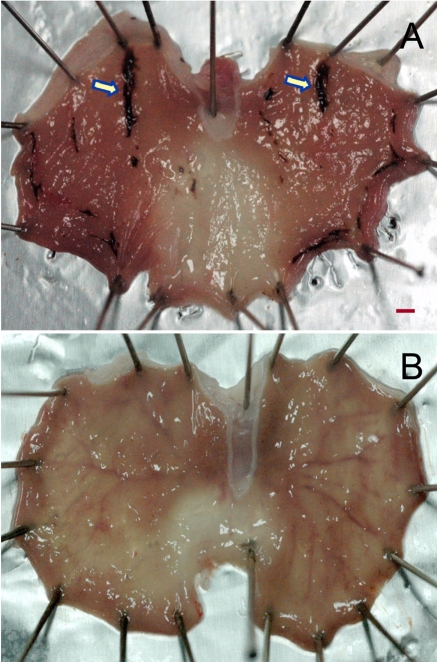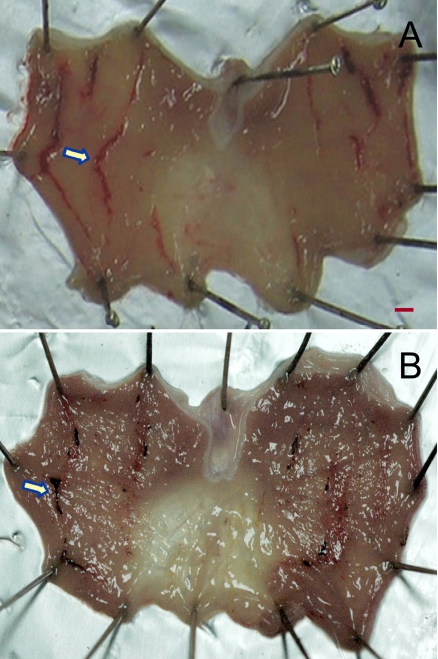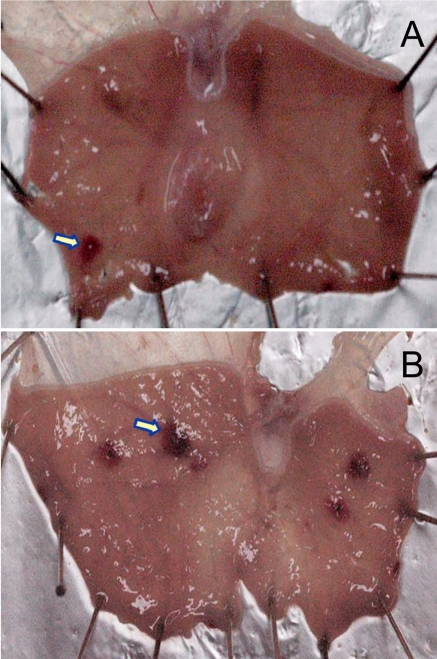Lab Anim Res.
2011 Mar;27(1):47-52. 10.5625/lar.2011.27.1.47.
Different Antiulcer Activities of Pantoprazole in Stress, Alcohol and Pylorus Ligation-Induced Ulcer Models
- Affiliations
-
- 1College of Veterinary Medicine and Research Institute of Veterinary Medicine, Chungbuk National University, Cheongju, Republic of Korea. solar93@cbu.ac.kr
- 2Department of Biomedical Laboratory Science, Daejeon University, Daejeon, Republic of Korea.
- KMID: 2391858
- DOI: http://doi.org/10.5625/lar.2011.27.1.47
Abstract
- Antiulcer effects of pantoprazole, a proton-pump inhibitor, on water-immersion restraint stress (WIRS)-, alcohol (ethanol)- and pylorus ligation-induced gastric ulcers were investigated in male rats. Rats were orally administered with pantoprazole 30 min prior to exposure to various types of ulcer inducers. In stress-induced ulcer model, rats were subjected to WIRS at 22degrees C for 4 hours, and the degree of ulcer (in mm) was evaluated. In alcohol-induced ulcer model, rats were orally administered with pure (100%) ethanol (1 mL/kg), and the ulcer lesions were measured 1 hour after ethanol challenge. In pylorus ligation-induced ulcer model, rats were subjected to pylorus ligation, and the degree of erosions and ulcers was scored 17 hours after the operation. Pantoprazole attenuated the ulcer lesions induced by WIRS in a dose-dependent manner, exhibiting a median effective dose (ED50) value of 0.78 mg/kg. By comparison, pantoprazole was effective at relatively-high doses for the improvement of ethanol-induced ulcers, showing an ED50 value of 20.5 mg/kg. Notably, pantoprazole was practically ineffective (ED50>50.0) in pylorus ligation model. Taken together, it was confirmed that pantoprazole showed inhibitory activity on gastric ulcers induced by stress and alcohol, but was ineffective on pylorus ligation-induced ulcer. Therefore, the results indicate that proton-pump inhibitors including pantoprazole might reveal highly-different effects according to the type of ulcer inducers, and that the prescription of antiulcer agents should be carefully selected.
Keyword
MeSH Terms
Figure
Cited by 2 articles
-
Gastroprotective Effects of Glutinous Rice Extract against Ethanol-, Indomethacin-, and Stress-induced Ulcers in Rats
Dong Up Song, Mi Sun Jang, Hyun Woo Kim, Hyun Joong Yoon, Kee Oh Chay, Young Eun Joo, Young Do Jung, Sung Yeul Yang, Bong Whan Ahn
Chonnam Med J. 2014;50(1):6-14. doi: 10.4068/cmj.2014.50.1.6.Inhibitory effects of a β-dunnione compound MB12662 on gastric secretion and ulcers
In-Geun Jo, Dongsun Park, Jangbeen Kyung, Dajeong Kim, Jingmei Cai, Jihyun Kim, Tae Hwan Kwak, Sang-Ku Yoo, Heon-Sang Jeong, Yun-Bae Kim
Lab Anim Res. 2013;29(3):178-181. doi: 10.5625/lar.2013.29.3.178.
Reference
-
1. Byun SK, Lee YE, Shin SH, Jang JY, Choi BI, Park DS, Jeon JH, Nahm SS, Hwang SY, Kim YB. The role of corticosteroids in stress-induced gastric ulceration in rats. Lab Anim Res. 2007; 23:127–131.2. Cantarella G, Martinez G, Cutuli VM, Loreto C, D'Alcamo M, Prato A, Amico-Roxas M, Bernardini R, Clementi G. Adrenomedullin modulates COX-2 and HGF expression in reserpine-injured gastric mucosa in the rat. Eur J Pharmacol. 2005; 518:221–226. PMID: 16081063.3. Cantarella G, Martinez G, Di Benedetto G, Loreto C, Musumeci G, Prato A, Lempereur L, Matera M, Amico-Roxas M, Bernardini R, Clementi G. Protective effects of amylin on reserpine-injured gastric damage in the rat. Pharmacol Res. 2007; 56:27–34. PMID: 17412609.4. Cao H, Wang MW, Jia JH, Wang QG, Cheng MS. Comparison of the effects of pantoprazole enantimers on gastric mucosal lesions and gastric epithelial cells in rats. J Health Sci. 2004; 50:1–8.5. Cao H, Wang MW, Sun LX, Ikejima T, Hu ZQ, Zhao WH. Pharmacodynamic comparison of pantoprazole enantimers: inhibition of acid-related lesions and acid secretion in rats and guinea-pigs. J Pharm Pharmacol. 2005; 57:923–927. PMID: 15969954.6. Das D, Banerjee RK. Effect of stress on the antioxidant enzymesand gastric ulceration. Mol Cell Biochem. 1993; 125(2):115–125. PMID: 8283967.7. Dias PC, Foglio MA, Possenti A, de Carvalho JE. Antiulcerogenic activity of crude hydroalcoholic extract of Rosmarinus officinalis L. J Ethnopharmacol. 2000; 69:57–62. PMID: 10661884.8. Filaretova L, Tanaka A, Miyazawa T, Kato S, Takeuchi K. Mechanisms by which endogenous glucocorticoid protects against indomethacin-induced gastric injury in rats. Am J Physiol Gastrointest Liver Physiol. 2002; 283:G1082–G1089. PMID: 12381521.9. Fitton A, Wiseman L. Pantoprazole: a review of its pharmacological properties and therapeutic use in acid-related disorders. Drugs. 1996; 51:460–482. PMID: 8882382.10. Fujii Y, Matsura T, Kai M, Matsui H, Kawasaki H, Yamada K. Mitochondrial cytochrome c release and caspase-3-like protease activation during indomethacin-induced apoptosis in rat gastric mucosal cells. Proc Soc Exp Biol Med. 2000; 224(2):102–108. PMID: 10806417.
Article11. Hemmer J, Schwille PO, Schellerer W, Hofmann W. Effects of cimetidine upon gastric secretion and mucosal blood flow in the rat stressed by restraint. A dose-response and prophylaxis trial. Res Exp Med. 1980; 176(3):207–217.12. Işbil Büyükcoşkun N, Güleç G, Ozlük K. Protective effect of centrally-injected glucagons-like peptide-1 on reserpine-induced gastric mucosal lesions in rat: possible mechanisms. Turk J Gastroenterol. 2006; 17:1–6. PMID: 16830270.13. Isobe H, Okajima K, Harada N, Liu W, Okabe H. Activated protein C reduces stress-induced gastric mucosal injury in rats by inhibiting the endothelial cell injury. J Thromb Haemost. 2004; 2:313–320. PMID: 14995995.
Article14. Jungnickel PW. Pantoprazole: a new proton pump inhibitor. Clin Ther. 2000; 22:1268–1293. PMID: 11117653.
Article15. Kim YR, Lee MR, Kim YH, Jang BJ, Park SC, Han SH, Kim BH, Ryoo ZY, Kim KS. Effect of Opuntiahumifusa extract on indomethacin-induced gastric ulcer in Sprague Dawley rat. Lab Anim Res. 2005; 21:375–578.16. Kim JJ, Kim CH, Park D, Shin S, Jeon JH, Jang MJ, Ji HJ, O N, Song J, Lee J, Kim B-Y, Choi EK, Joo SS, Hwang S-Y, Kim YB. Effects of sweet potato fractions on alcoholic hangover and gastric ulcer. Lab Anim Res. 2008; 24:209–216.17. Kitagawa H, Fujiwara M, Osumi Y. Effects of water-immersion stress on gastric secretion and mucosal blood flow in rats. Gastroenterology. 1979; 77:298–302. PMID: 447044.
Article18. Konturek PK, Brzozowski T, Konturek SJ, Dembinski A. Role of epidermal growth factor, prostaglandin and sulfhydryls in stress induced gastric lesions. Gastroenterology. 1990; 99(6):1607–1615. PMID: 2227276.19. Konturek SJ, Brzozowski T, Radecki T. Protective action of omeprazole, a benzimidazole derivative on gastric mucosal damage by aspirin and ethanol in rats. Digestion. 1983; 27:159–164. PMID: 6354810.
Article20. Kromer W, Postius S, Riedel R, Simon WA, Hanauer G, Brand U, Gönne S, Parsons ME. BY 1023/SK&F96022 Inn pantoprazole, a novel gastric proton pump inhibitor, potently inhibits acid secretion but lacks relevant cytochrome P450 interactions. J Pharmacol Exp Ther. 1990; 254:129–135. PMID: 2164086.21. Lindberg P, Nordberg P, Alminger T, Brandstrom A, Wallmark B. The mechanism of action of the gastric acid secretion inhibitor omeprazole. J Med Chem. 1986; 29:1327–1329. PMID: 3016260.22. Lou LX, Geng B, Yu F, Zhang J, Pan CS, Chen L, Qi YF, Ke Y, Wang X, Tang CS. Endoplasmic reticulum stress response in involved in the pathogenesis of stress induced gastric lesions in rats. Life Sci. 2006; 79:1856–1864. PMID: 16875701.23. Neal MJ. Medical Pharmacology at a Glance. 2003. 3rd ed. London: Blackwell Publishing Inc;p. 30–31.24. Piotrowski J, Piotrowski E, Skrodzka D, Slomiany A, Slomiany BL. Gastric mucosal apoptosis induced by ethanol: effect ofantiulcer agents. Biochem Mol Biol Int. 1997a; 42(2):247–254. PMID: 9238522.25. Piotrowski J, Piotrowski E, Skrodzka D, Slomiany A, Slomiany BL. Induction of acute gastritis and epithelial apoptosis by Helicobacter pylori lipopolysaccharide. Scand J Gastroenterol. 1997b; 32(3):203–211. PMID: 9085455.26. Raffin RP, Colomé LM, Schapoval EE, Jornada DS, Pohlmann AR, Guterres SS. Gastro-resistant microparticles containing sodium pantoprazole: stability and in vivo anti-ulcer activity. Open Drug Deliv J. 2007; 1:28–35.27. Rao ChV, Ojha SK, Radhakrishnan K, Govindarajan R, Rastogi S, Mehrotra S, Pushpangadan P. Antiulcer activity of Utleria salicifolia rhizome extract. J Ethnopharmacol. 2004; 91:243–249. PMID: 15120446.28. Robert A, Nezamis JE, Lancaster C, Hanchar AJ. Cytoprotection by prostaglandins in rats. Gastroenterology. 1979; 77:433–443. PMID: 456839.
Article29. Shah PJ, Gandhi MS, Shah MB, Goswami SS, Santani D. Study of Minusopd elengi bark in experimental gastric ulcers. J Ethnopharmacol. 2003; 89:305–311. PMID: 14611897.30. Shay M, Komarov SA, Fels D, Meranze D, Gruenstein H. A simple method for the uniform production of gastric ulceration in the rat. Gastroenterology. 1945; 5:43–61.31. Slomiany BL, Piotrowski J, Slomiany A. Induction of tumor necrosis factor-alpha and apoptosis in gastric mucosal injury by indomethacin: effect of omeprazole and ebrotidine. Scand J Gastroenterol. 1997; 32(7):638–642. PMID: 9246701.32. Wallace JL, Granger DN. The cellular and molecular basis of gastric mucosal defense. FASEB J. 1996; 10:731–740. PMID: 8635690.
Article33. Wallmark B, Larsson H, Humble L. The relationship between gastric acid secretion and gastric H+, K+-ATPase activity. J Biol Chem. 1985; 260(25):13681–13684. PMID: 2997178.
- Full Text Links
- Actions
-
Cited
- CITED
-
- Close
- Share
- Similar articles
-
- Inhibitory effects of a beta-dunnione compound MB12662 on gastric secretion and ulcers
- A Case of Double Pylorus Presenting with Ulcer Bleeding
- Efficacy of 1-week Pantoprazole-Based Triple Therapy in Eradicating Helicobacter pylori without Additional Acid Suppression Therapy
- A Case of Double Pylorus Accompanied by Duodenal Ulcer
- A Case of Double Pylorus Associated with Ectopic Pancreas Presenting with Gastric Ulcer Bleeding




